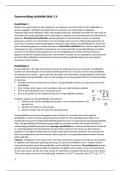3) Harmonic series :
𝟏
They are of the form : ∑𝒏≥𝟏 𝒏
• Reminders :
1. A numerical sequence of real numbers (𝑎𝑛 )𝑛 is a Cauchy sequence if : ∀𝜀 > 0 ; ∃𝑁 ∈ ℕ ,
such that : ∀𝑝 > 𝑞 > 𝑁, we have : |𝑎𝑝 − 𝑎𝑞 | < 𝜀.
2. (𝑎𝑛 )𝑛 is a convergente sequence if : ∃𝑙 ∈ ℝ , such that : lim 𝑎𝑛 = 𝑙 ⟺ ∀𝜀 > 0 , ∃𝑛0 ; such
𝑛→+∞
that : ∀𝑛 > 𝑛0 , we have : |𝑢𝑛 − 𝑙| < 𝜀.
3. The real number sequence (𝑎𝑛 )𝑛 is a Cauchy sequence if and only if it is convergent.
4. (𝑎𝑛 )𝑛 is a sequence that is not Cauchy if : ∃𝜀0 > 0 ; ∀𝑁 ∈ ℕ ; ∃𝑝0 , 𝑞0 > 𝑁, such that :
|𝑎𝑝0 − 𝑎𝑞0 | ≥ 𝜀0 .
1
Let's consider the sequence of partial sums 𝑆𝑛 = ∑𝑛𝑘=1 𝑘 , and let 𝑝0 = 2𝑛 , 𝑞0 = 𝑛.
1 1
We have : 𝑆𝑝0 − 𝑆𝑞0 = 𝑆2𝑛 − 𝑆𝑛 = ∑2𝑛 𝑛
𝑘=1 𝑘 − ∑𝑘=1 𝑘
1 1 1 1 1 1
𝑆2𝑛 − 𝑆𝑛 = + + ⋯+ ≥ + + ⋯+
𝑛+1 𝑛+2 2𝑛 2𝑛 2𝑛 2𝑛
𝑛 terms
𝑛 1
𝑆2𝑛 − 𝑆𝑛 ≥ =
2𝑛 2
1
We have the following : ∃𝜀0 = 2 ; ∀𝑛 ; ∃𝑝0 = 2𝑛 ; ∃𝑞0 = 𝑛 , such that :
1
|𝑆2𝑛 − 𝑆𝑛 | > 𝜀0 =
2
1
Then : (𝑆𝑛 )𝑛 diverges, so the harmonic series ∑𝑛≥1 𝑛 diverges.
• Properties and operations on series :
1. The nature of a series is not changed if we add or subtract a finite number of its terms.
2. In the case of convergence, it is the sum that changes when adding or subtracting terms. The
series ∑𝑛≥0 𝑢𝑛 and ∑𝑛≥𝑛0 𝑢𝑛 remains of the same nature but with a different sum.
1
Example : ∑𝑛≥0 (𝑛+1)(𝑛+2) = 1
1 1 1 1 1 1
Let be : ∑𝑛≥2 (𝑛+1)(𝑛+2) ; we have : 𝑇𝑛 = ∑𝑛𝑘=2 (𝑘+1)(𝑘+2) = ∑𝑛𝑘=2 (𝑘+1 − 𝑘+2) = 3 − 𝑛+2
1 1 1
lim 𝑇𝑛 = 3 ; so : ∑𝑛≥2 (𝑛+1)(𝑛+2) = 3
𝑛→+∞
3. Let ∑𝑛≥0 𝑢𝑛 and ∑𝑛≥0 𝑣𝑛 be two series. If ∑𝑛≥0 𝑢𝑛 converges with sum 𝑆 and ∑𝑛≥0 𝑣𝑛
converges with sum 𝑆′, then the series ∑𝑛≥0(𝑢𝑛 + 𝑣𝑛 ) converges with sum 𝑆 + 𝑆′.
4. Let 𝛼 ∈ ℝ∗ . If ∑𝑛≥0 𝑢𝑛 converges with sum 𝑆, then the series ∑𝑛≥0(𝛼𝑢𝑛 ) converges with sum
𝛼𝑆.
𝟏
They are of the form : ∑𝒏≥𝟏 𝒏
• Reminders :
1. A numerical sequence of real numbers (𝑎𝑛 )𝑛 is a Cauchy sequence if : ∀𝜀 > 0 ; ∃𝑁 ∈ ℕ ,
such that : ∀𝑝 > 𝑞 > 𝑁, we have : |𝑎𝑝 − 𝑎𝑞 | < 𝜀.
2. (𝑎𝑛 )𝑛 is a convergente sequence if : ∃𝑙 ∈ ℝ , such that : lim 𝑎𝑛 = 𝑙 ⟺ ∀𝜀 > 0 , ∃𝑛0 ; such
𝑛→+∞
that : ∀𝑛 > 𝑛0 , we have : |𝑢𝑛 − 𝑙| < 𝜀.
3. The real number sequence (𝑎𝑛 )𝑛 is a Cauchy sequence if and only if it is convergent.
4. (𝑎𝑛 )𝑛 is a sequence that is not Cauchy if : ∃𝜀0 > 0 ; ∀𝑁 ∈ ℕ ; ∃𝑝0 , 𝑞0 > 𝑁, such that :
|𝑎𝑝0 − 𝑎𝑞0 | ≥ 𝜀0 .
1
Let's consider the sequence of partial sums 𝑆𝑛 = ∑𝑛𝑘=1 𝑘 , and let 𝑝0 = 2𝑛 , 𝑞0 = 𝑛.
1 1
We have : 𝑆𝑝0 − 𝑆𝑞0 = 𝑆2𝑛 − 𝑆𝑛 = ∑2𝑛 𝑛
𝑘=1 𝑘 − ∑𝑘=1 𝑘
1 1 1 1 1 1
𝑆2𝑛 − 𝑆𝑛 = + + ⋯+ ≥ + + ⋯+
𝑛+1 𝑛+2 2𝑛 2𝑛 2𝑛 2𝑛
𝑛 terms
𝑛 1
𝑆2𝑛 − 𝑆𝑛 ≥ =
2𝑛 2
1
We have the following : ∃𝜀0 = 2 ; ∀𝑛 ; ∃𝑝0 = 2𝑛 ; ∃𝑞0 = 𝑛 , such that :
1
|𝑆2𝑛 − 𝑆𝑛 | > 𝜀0 =
2
1
Then : (𝑆𝑛 )𝑛 diverges, so the harmonic series ∑𝑛≥1 𝑛 diverges.
• Properties and operations on series :
1. The nature of a series is not changed if we add or subtract a finite number of its terms.
2. In the case of convergence, it is the sum that changes when adding or subtracting terms. The
series ∑𝑛≥0 𝑢𝑛 and ∑𝑛≥𝑛0 𝑢𝑛 remains of the same nature but with a different sum.
1
Example : ∑𝑛≥0 (𝑛+1)(𝑛+2) = 1
1 1 1 1 1 1
Let be : ∑𝑛≥2 (𝑛+1)(𝑛+2) ; we have : 𝑇𝑛 = ∑𝑛𝑘=2 (𝑘+1)(𝑘+2) = ∑𝑛𝑘=2 (𝑘+1 − 𝑘+2) = 3 − 𝑛+2
1 1 1
lim 𝑇𝑛 = 3 ; so : ∑𝑛≥2 (𝑛+1)(𝑛+2) = 3
𝑛→+∞
3. Let ∑𝑛≥0 𝑢𝑛 and ∑𝑛≥0 𝑣𝑛 be two series. If ∑𝑛≥0 𝑢𝑛 converges with sum 𝑆 and ∑𝑛≥0 𝑣𝑛
converges with sum 𝑆′, then the series ∑𝑛≥0(𝑢𝑛 + 𝑣𝑛 ) converges with sum 𝑆 + 𝑆′.
4. Let 𝛼 ∈ ℝ∗ . If ∑𝑛≥0 𝑢𝑛 converges with sum 𝑆, then the series ∑𝑛≥0(𝛼𝑢𝑛 ) converges with sum
𝛼𝑆.










